Our second AACCRE trip in 2019 was quite an adventure into the Canadian High Arctic, based mainly from the hamlet of Aujuittuq (Grise Fiord), as well as a lesson in Arctic field logistics! Fortunately we had great support from Blackfeather and the Flight Centre…excellent resources and highly recommended for remote travel. Our basic travelogue is below, with images to supplement what we observed and accomplished. For traveling in this part of the High Arctic it is essential to get travel interruption insurance!
Day 1: travel from U.S. to Ottawa
- uneventful travel day but good to get all six of us together and into Canada with gear and luggage (that didn’t last unfortunately at least for luggage!)
- after checking into a local hotel I returned to the airport to meet up with a University of Ottawa collaborator (Luke Copland; one of leading glacier scientists in Canada) to discuss future High Arctic plans – airports are increasingly the place to meet for remote travelers;)
Day 2: travel from Ottawa north into Nunavut
- the day started OK from Ottawa airport but there were early signals of potential problems
- while checking in at airport we saw a large group also checking in – this group was heading to Greenland via Iqaluit to start a NW passage cruise (one of the lecturers on the cruise was UBC Prof Lee Groat – best mineralogist in Canada and great person; it was fantastic getting a chance to visit with him in Ottawa airport briefly!); little did we know that one of our bags was going to end up going through the passage via ship instead of with us!
- we had some hints of weather trouble after landing in Iqaluit and waiting for our flights north, which were supposed to go from Iqaluit to Mittimatalik (Pond Inlet) to Qausuittuq (Resolute, Cornwallis Island); unfortunately in August travel north has lots of uncertainties, including where planes have to land to get fuel (it can be in short supply until sealift arrives in late August/early September) and where they can land in case of bad weather; one striking difference from our trip in 2018 (granted it was two weeks earlier in the summer) was the lack of sea ice in northern Foxe Basin – we didn’t seen any sea ice at all during the flight…
- our trip north was initially uneventful, and our first stop was on the northwestern shore of the Foxe Basin (large body of water immediately north of Hudson Bay) for fuel at Igloolik (YGT); this first leg of the flight we saw lots of permafrost features on western Baffin Island, and excellent raised beaches near Igloolik
- next stop was Mittimatalik – gateway to the High Arctic; we were based out of Mittimatalik during our 2016 Floe Edge trip with Blackfeather and look forward to getting there again sometime in the not too distant; we were forewarned at that point that the weather in Qausuittuq was not looking too good (fog and clouds had reduced visibility to less than 0.5 miles), but everyone was keen to try
- we made it to Qausuittuq with some gorgeous views of glacials along the way, but it got cloudier as we got closer, and in the end we circled the airport for more than 30 minutes before deciding to abandon the weather and head back south
- we ended up spending the night at a new spot for AACCRE travel – Taloyoak! Very close to the western end of the NW passage, but we didn’t have time to see much…a bit of a fiasco as options for food were almost non-existent; this is where we first realized that we were missing a bag! So long day of travel, ending in disappointment at not getting to our objective, and loss of a critical piece of luggage dampened spirits a bit…little did we know this was just the beginning of logistical rearrangements…
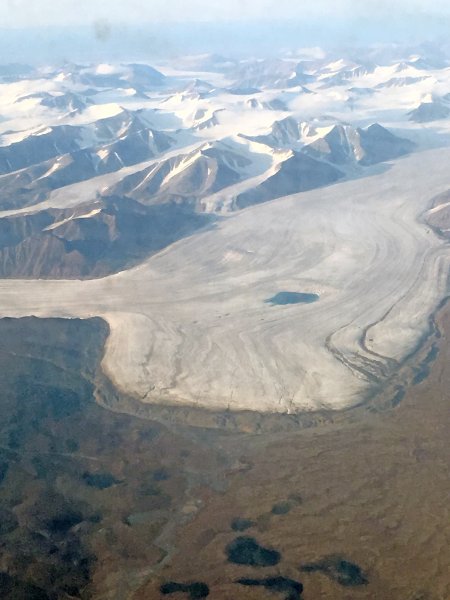
Aerial view of the terminus of an outlet glacier from the Bylot Island ice fields
Days 3-5: travel back to Iqaluit
- we awoke next morning expecting/hoping to get a second try at Qausuittuq, but instead the plane was recalled to Iqaluit; this was the beginning of an unexpected 3 day stay in Iqaluit while we waited for another group of 6 seats to become available on the flights (after this first adventure I wasn’t keen on splitting students into smaller groups as there was no way to know how scattered we could get across Baffin Island!); during the 3 partial days we spent in Iqaluit, we got to know some local residents, toured the town, the Nunatta Sunakkutaangit Museum (https://www.nunattasunakkutaangit.ca/home), and the Nunavut Arctic College (https://arcticcollege.ca); we also explored the tundra around town and visited Iqaluit Kuunga (Sylvia Grinnell territorial park; https://nunavutparks.com/parks-special-places/sylvia-grinnell-territorial-park/), and had two nights of fantastic northern lights
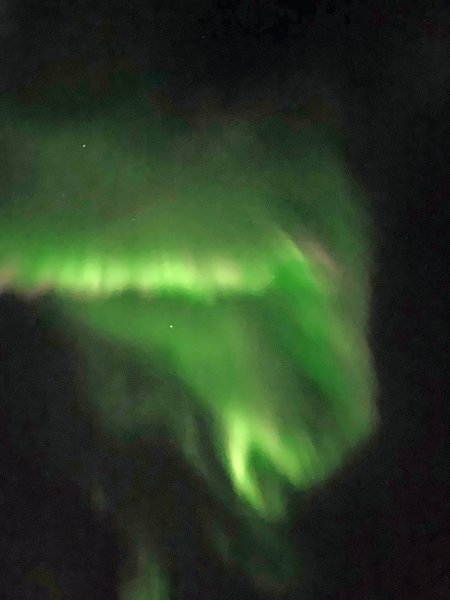
Northern Lights above Iqaluit, August 2019
Day 6: finally back in the air, we were able to retrace our route (sans stopping) straight to Mittimatalik, and from there to Qausuittuq where our Blackfeather field coordinator had been patiently waiting; in the end, although some of our ‘flight mates’ from our first attempt had gotten to Qausuittuq a day or two earlier, they had been stuck there waiting for clear weather to fly to Aujuittuq (Grise Fiord) too; we spent in the night in the expensive-but-excellent South Camp Inn where we finalized our gear packing and ate extremely well; we had our first encounter with sea ice (and got a bit wet!) and visited the statue commemorating the first people who were moved to Resolute Bay to establish one of the two permanent Canadian High Arctic communities
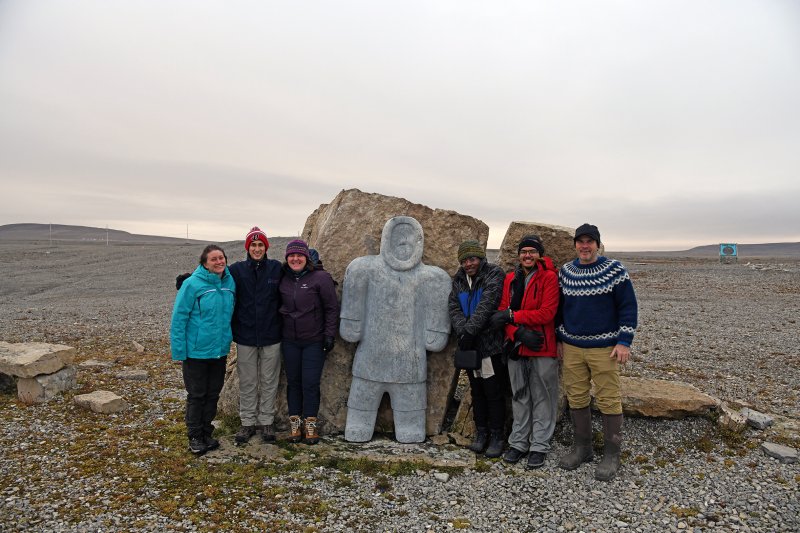
First High Arctic experience with short outing to the memorial commemorating Inuit families who were relocated to Qausuittuq (Resolute) in 1953 and 1955
Day 7: on our way to Aujuittuq!! amazing flight into Aujuittuq (Grise Fiord), spectacular views although a bit cloudy; we met our Arctic guide Terry Noah and moved in to what would become our temporary ‘field base’ (the Co-op Hotel) while we waited out calmer seas so that we could boat to our final objective (a remote campsite and glacier accessed through the actual fiord named ‘Grise Fiord’, which is just west of the village of Aujuittuq); we spent a total of 6 days in Aujuittuq, including planned hikes to two different glaciers and unplanned visits with local officials including the mayor and the village administrators; the people were very welcoming and the kids (Dickinson ‘older’ kids and Aujuittuq ‘younger’ kids) got to interact quite a bit, which added an unplanned but incredible dimension to this AACCRE trip
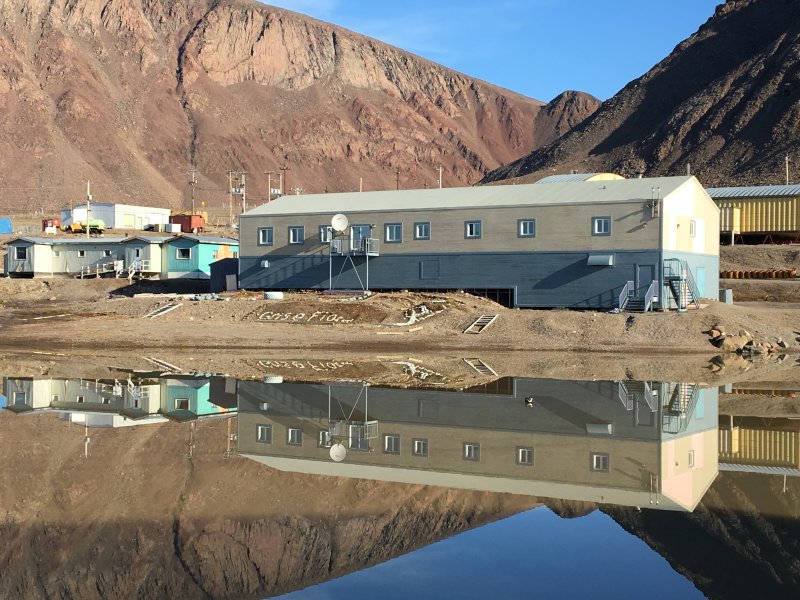
Reflection of Aujuittuq clinic and hamlet building
Days 8-9: did day hikes around Aujuittuq, including a hike to small remnants of a glacier immediately north of the hamlet; this ice is the main water source for Aujuittuq and the people who live there; we also hiked to a still active but small glacier to the east of town, which is accessed first via a short drive (~4 km) and then a 1 hour hike; for several of the students this was the first time in their lives they experienced a glacier in person! also our first group hikes over moraine-covered ground, which can be tricky; everyone did well on the hike, and this prepared us for our extended remote travel on the following days
Days 10-12: we loaded Terry’s boat with gear, along with our other bear guide Ben and Biguous-the-bear-dog; after about an hour of boat travel into Grise Fiord we landed at a large beach formed by a delta that sits at the mouth of what is now a small stream; we setup camp and did a short hike to the top of the delta complex, which has likely been elevated by isostatic rebound (we found fragments of sea shells up to the top of the delta, which was well above modern and likely ancient sea level); the next morning we packed up heavy packs, boated to the northern end of the delta to avoid a wet stream crossing, and hiked up to our final destination – the terminus of a small outlet glacier; although the hike was not particularly long, much of it was within a rocky stream valley, so going to was slow to keep ankles safe! We had a fantastic day and hope to revisit this site in the future – incredible geology along the way and access to the base of this frozen-based glacier; the following day we had to catch the mid-day tide to be able to get the boat off the beach and head back to Aujuittuq; it took a bit of pushing and digging, but we finally got back in the water while the tide was high; on the way back we stopped to see an ancient polar bear trap made from boulders (we saw lots of smaller versions of this type of trap in Alexander Fiord during our 2018 expedition)
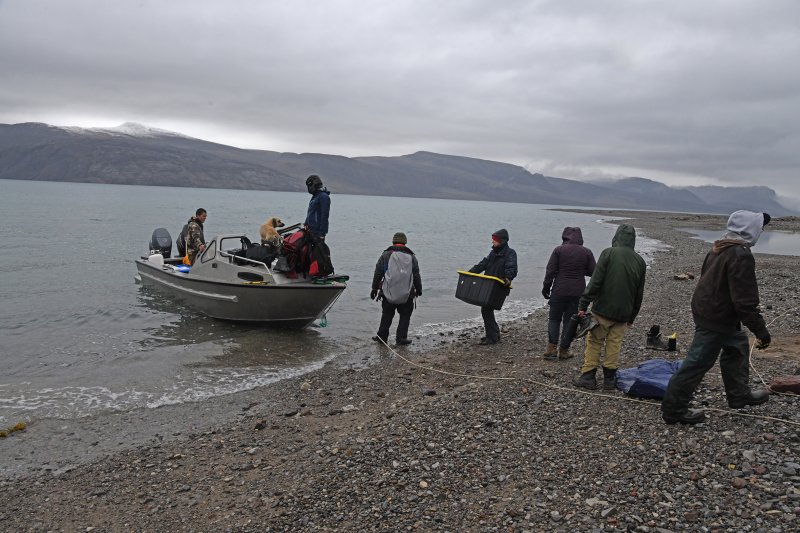
Loading camp into marine transport, Grise Fiord
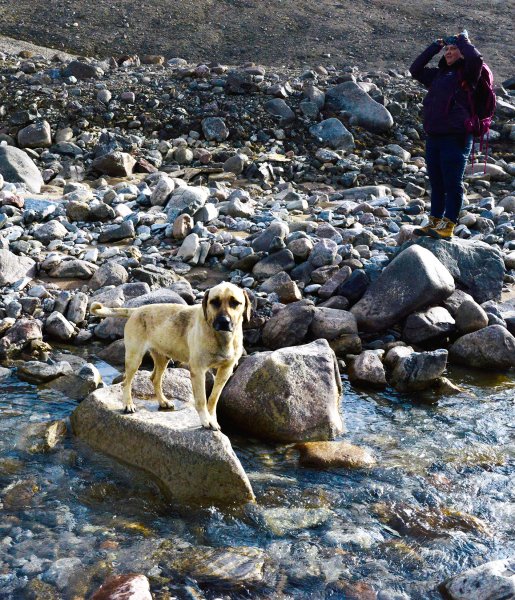
We were very happy to have Biguous with us on our camping trip! He was mostly an excellent companion (expect that he liked to ‘mark’ equipment bags:), very friendly and alert and an incredible glacier traveler!
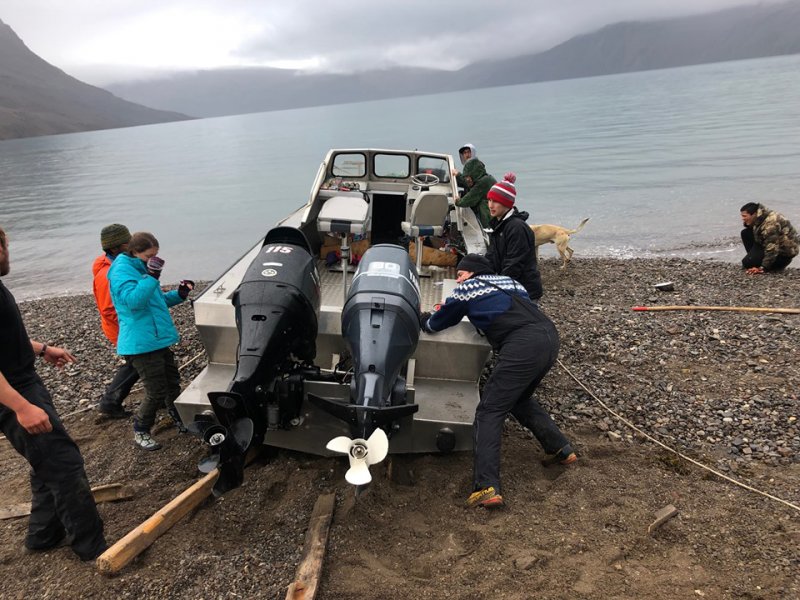
High winds and tide left the boat up on the beach, but with a bit of elbow grease, digging and ingenuity we were able to catch the high tide and head out.
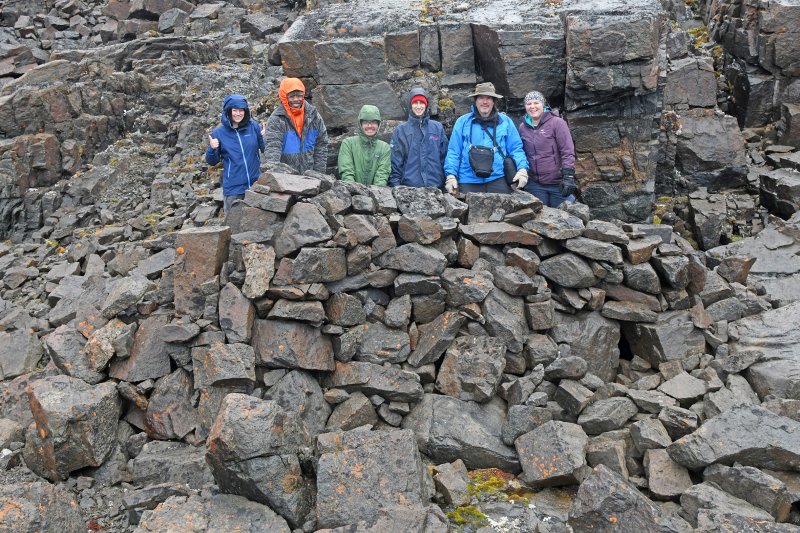
This is a stone bear trap along the shore of an island near Aujuittuq; the trap was baited and once the bear crawled in the tight space, it was difficult for it to back out and it could be ‘captured’
Days 13-14: weather kept us ‘stuck’ in Aujuittuq for another two days, so we used the time to continue to explore the hamlet and visit with residents; we had a great evening with the mayor and Terry’s family, and left feeling like we had a much better appreciation for many of the issues facing people living in the High Arctic; on day 14 we even got a brief glimpse of a passing group of beluga whales, which was fast-paced but fantastic
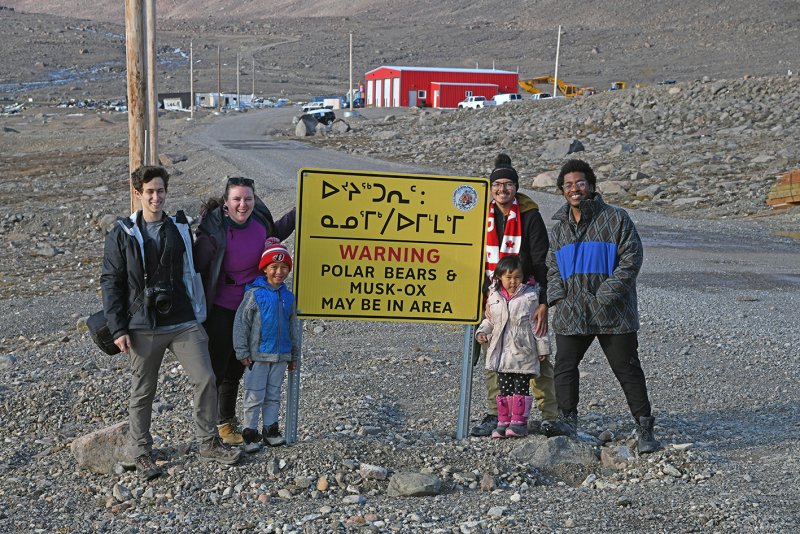
We did several town walks to explore the edges of the hamlet with local Aujuittuq experts as our guides
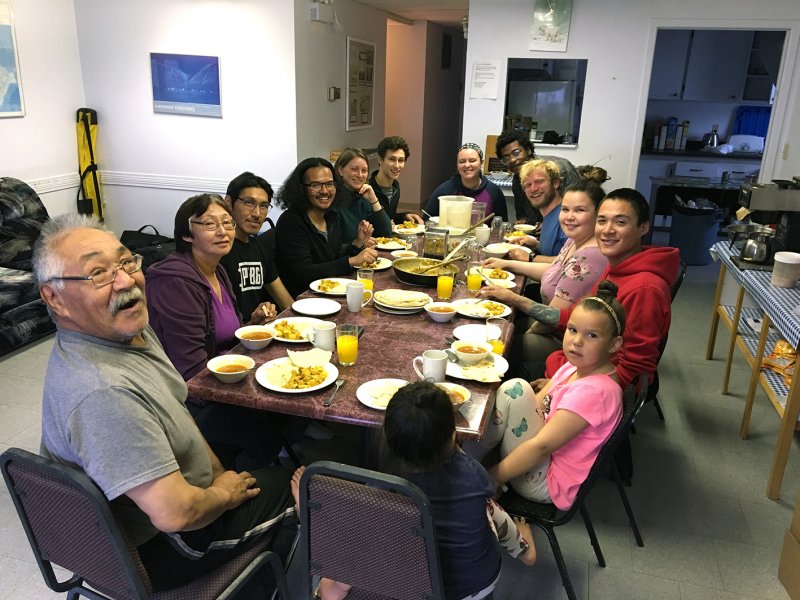
We were honored by the mayor and Terry’s family to share dinner with us at our ‘co-copted’ Co-op base camp
Days 15-16: we departed Aujuittuq for Qausuittuq, but now were far enough off-schedule that we were stuck in Qausuittuq for two full days waiting for seats on a flight back to Iqaluit (planes generally weren’t full to get from Qausuittuq to Mittimatalik, but from Mittimatalik south we couldn’t get 6 seats); we made good use of this time by exploring the area around Qausuittuq, including a long hike to the east where we saw lots of patterned ground and an amazing stream cascade, visiting with people who briefly landed for coffee during a NW passage cruise (unfortunately not the one with our missing bag!), and getting to watch a small polar bear taking a temporary break from a passing ice floe to explore for eatable items in the Qausuittuq dump (this was on our last evening in Qausuittuq and marked an interesting moment for me, because my father had spend a summer in Qausuittuq in the 1950’s and had seen a polar bear at the same dump!); fortunately the South Camp Inn also had internet access, so students were busy getting caught up on assignments and even writing papers for classes while we waited for open seats
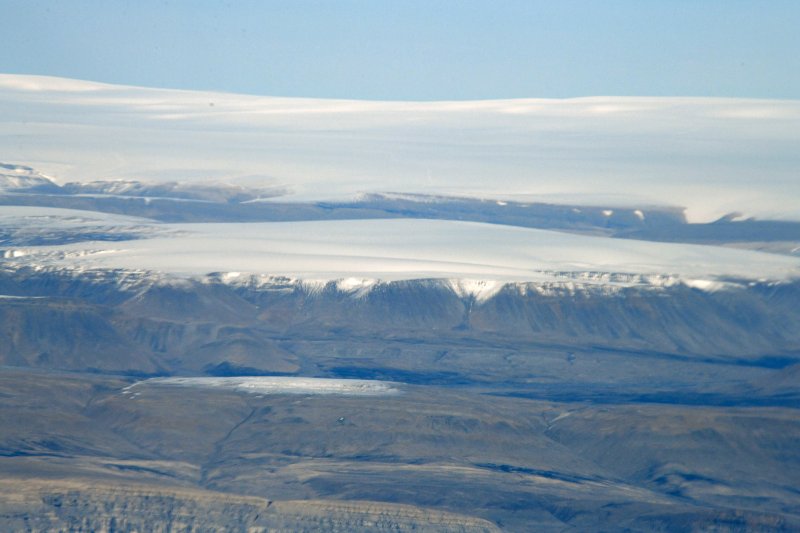
View looking to the north as glaciers on the southern edge of Ellesmere Island.
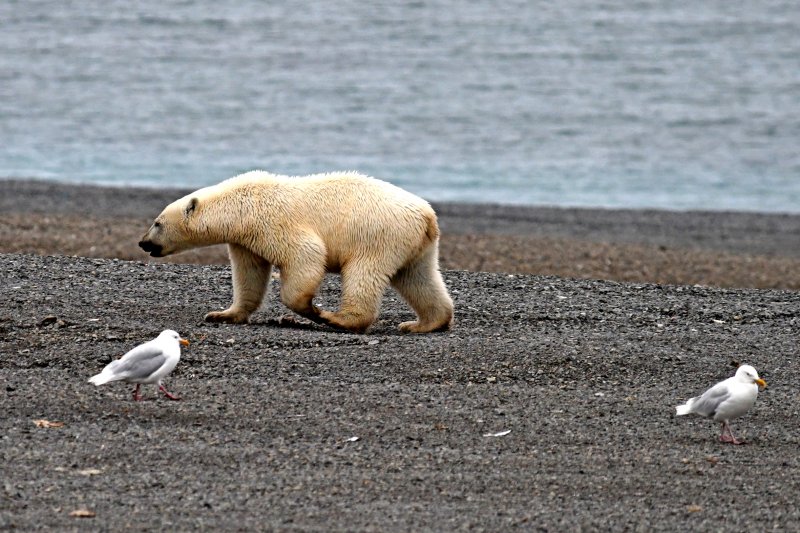
Polar bear taking a quick break from hunting the ice floes to visit Qausuittaq and look for a quick ‘beach’ snack
Day 17: long day of flights but we ended the day in Ottawa; we were reunited with our missing bag, and had an excellent farewell dinner
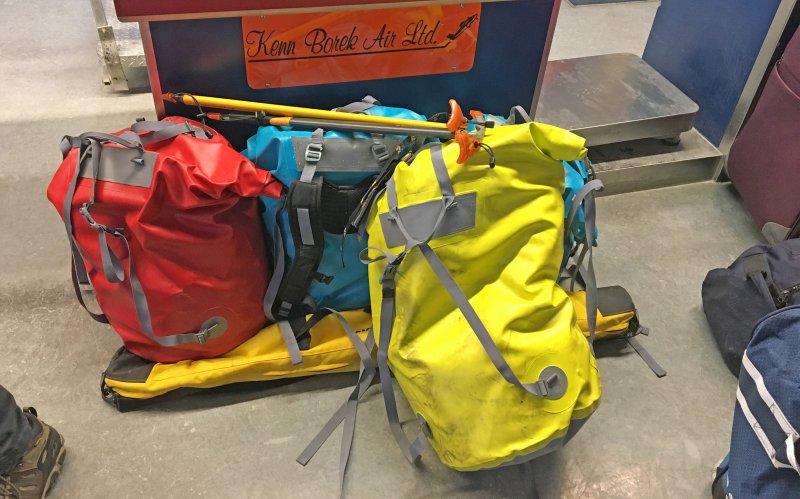
Our gear waiting to be loaded onto the plane – one of these distinctive bags went on a spurious journey via boat through the NW passage before returning to us!
Day 18: four days late but made it back to campus before the end of the first week of classes – a memorable Arctic adventure with many lessons about places, people, logistics and climate change learned

Leave a Reply